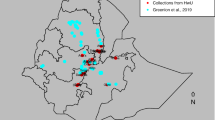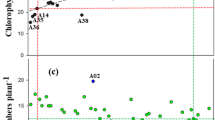Abstract
Crop domestication, in general, has reduced genetic diversity in cultivated gene pool of chickpea (Cicer arietinum) as compared with wild species (C. reticulatum, C. bijugum). To explore impact of domestication on symbiosis, 10 accessions of chickpeas, including 4 accessions of C. arietinum, and 3 accessions of each of C. reticulatum and C. bijugum species, were selected and DNAs were extracted from their nodules. To distinguish chickpea symbiont, preliminary sequences analysis was attempted with 9 genes (16S rRNA, atpD, dnaJ, glnA, gyrB, nifH, nifK, nodD and recA) of which 3 genes (gyrB, nifK and nodD) were selected based on sufficient sequence diversity for further phylogenetic analysis. Phylogenetic analysis and sequence diversity for 3 genes demonstrated that sequences from C. reticulatum were more diverse. Nodule occupancy by dominant symbiont also indicated that C. reticulatum (60%) could have more various symbionts than cultivated chickpea (80%). The study demonstrated that wild chickpeas (C. reticulatum) could be used for selecting more diverse symbionts in the field conditions and it implies that chickpea domestication affected symbiosis negatively in addition to reducing genetic diversity.

Similar content being viewed by others
References
Agarwal G, Jhanwar S, Priya P, Singh VK, Saxena MS, Parida SK, Garg R, Tyagi AK and Jain M 2012 Comparative analysis of kabuli chickpea transcriptome with desi and wild chickpea provides a rich resource for development of functional markers. PLoS ONE 7 e52443
Ben Romdhane S, Aouani ME, Trabelsi M, De Lajudie P and Mhamdi R 2008 Selection of high nitrogen-fixing Rhizobia nodulating chickpea (Cicer arietinum) for semi-arid Tunisia. J. Agron. Crop Sci. 194 413–420
Ben Romdhane S, Tajini F, Trabelsi M, Aouani M and Mhamdi R 2007 Competition for nodule formation between introduced strains of Mesorhizobium ciceri and the native populations of rhizobia nodulating chickpea (Cicer arietinum) in Tunisia. World J. Microbiol. Biotechnol. 23 1195–1201
Chen W-M, Zhu W-F, Bontemps C, Young JPW and Wei GH 2010 Mesorhizobium alhagi sp. nov., isolated from wild Alhagi sparsifolia in north-western China. Int. J. Syst. Evol. Microbiol. 60 958–962
Doebley JF, Gaut BS and Smith BD 2006 The molecular genetics of crop domestication. Cell 127 1309–1321
Fridman E, Carrari F, Liu Y-S, Fernie AR and Zamir D 2004 Zooming in on a quantitative trait for tomato yield using interspecific introgressions. Science 305 1786–1789
Hajjar R and Hodgkin T 2007 The use of wild relatives in crop improvement: a survey of developments over the last 20 years. Euphytica 156 1–13
Kiers ET, Hutton MG and Denison RF 2007 Human selection and the relaxation of legume defences against ineffective rhizobia. Proc. R. Soc. B. 274 3119–3126
Laguerre G, Nour SM, Macheret V, Sanjuan J, Drouin P and Amarger N 2001 Classification of rhizobia based on nodC and nifH gene analysis reveals a close phylogenetic relationship among Phaseolus vulgaris symbionts. Microbiology 147 981–993
Laranjo M, Alexandre A, Rivas R, Velázquez E, Young JPW and Oliveira S 2008 Chickpea rhizobia symbiosis genes are highly conserved across multiple Mesorhizobium species. FEMS Microbiol. Ecol. 66 391–400
Laranjo M, Young JPW and Oliveira S 2012 Multilocus sequence analysis reveals multiple symbiovars within Mesorhizobium species. Syst. Appl. Microbiol. 35 359–367
Lenser T and Theissen G 2013 Molecular mechanisms involved in convergent crop domestication. Trends Plant Sci. doi: 10.1016/j.tplants.2013.08.007
Margaret I, Becker A, Blom J, Bonilla I, Goesmann A, Göttfert M, Lloret J, Mittard-Runte V, et al. 2011 Symbiotic properties and first analyses of the genomic sequence of the fast growing model strain Sinorhizobium fredii HH103 nodulating soybean. J. Biotechnol. 155 11–19
Martens M, Delaere M, Coopman R, De Vos P, Gillis M and Willems A 2007 Multilocus sequence analysis of Ensifer and related taxa. Int. J. Syst. Evol. Microbiol. 57 489–503
McCouch S, Baute GJ, Bradeen J, Bramel P, Bretting PK, Buckler E, Burke JM, Charest D, et al. 2013 Agriculture: Feeding the future. Nature 499 23–24
Ohri D and Pal M 1991 The origin of chickpea (Cicer arietinum L.): karyotype and nuclear DNA amount. Heredity 66 367–372
Olsen KM and Wendel JF 2013 A bountiful harvest: genomic insights into crop domestication phenotypes. Annu. Rev. Plant Biol. 64 47–70
Ormeno-Orrillo E, Menna P, Almeida LG, Ollero FJ, Nicolas MF, Pains Rodrigues E, Shigueyoshi Nakatani A, Silva Batista JS, et al. 2012 Genomic basis of broad host range and environmental adaptability of Rhizobium tropici CIAT 899 and Rhizobium sp. PRF 81 which are used in inoculants for common bean (Phaseolus vulgaris L.). BMC Genomics 13 735
Sachs JL, Ehinger MO and Simms EL 2010 Origins of cheating and loss of symbiosis in wild Bradyrhizobium. J. Evol. Biol. 23 1075–1089
Schmalenbach I, Léon J and Pillen K 2009 Identification and verification of QTLs for agronomic traits using wild barley introgression lines. Theor. Appl. Genet. 118 483–497
Tamura K, Peterson D, Peterson N, Stecher G, Nei M and Kumar S 2011 MEGA5: molecular evolutionary genetics analysis using maximum likelihood, evolutionary distance, and maximum parsimony methods. Mol. Biol. Evol. 28 2731–2739
Thompson J, Reen R, Clewett T, Sheedy J, Kelly A, Gogel B and Knights E 2011 Hybridisation of Australian chickpea cultivars with wild Cicer spp. increases resistance to root-lesion nematodes (Pratylenchus thornei and P. neglectus). Australas. Plant Pathol. 40 601–611
Varshney RK, Song C, Saxena RK, Azam S, Yu S, Sharpe AG, Cannon S, Baek J, et al. 2013 Draft genome sequence of chickpea (Cicer arietinum) provides a resource for trait improvement. Nat. Biotech. 31 240–246
Weisburg WG, Barns SM, Pelletier DA and Lane DJ 1991 16S ribosomal DNA amplification for phylogenetic study. J. Bacteriol. 173 697–703
Wielbo J, Marek-Kozaczuk M, Mazur A, Kubik-Komar A and Skorupska A 2010 Genetic and metabolic divergence within a Rhizobium leguminosarum bv. trifolii population recovered from cover nodules. Appl. Environ. Microbiol. 76 4593–4600
White J, Navlakha S, Nagarajan N, Ghodsi M-R, Kingsford C and Pop M 2010 Alignment and clustering of phylogenetic markers - implications for microbial diversity studies. BMC Bioinformatics 11 152
Zahran HH 2001 Rhizobia from wild legumes: diversity, taxonomy, ecology, nitrogen fixation and biotechnology. J. Biotechnol. 91 143–153
Acknowledgements
This study has been supported by US National Science Foundation (NSF) – Basic Research Enabling Agriculture in Developing Countries (BREAD) grant entitled ‘Overcoming the Domestication Bottleneck for Symbiotic Nitrogen Fixation in Legumes’. The authors are thankful to Douglas R Cook and R Varma Penmetsa of University of California-Davis, and Eric von Wettbergof Florida International University, USA, for their help and support in various ways during the course of the study. This work has been undertaken as part of the CGIAR Research Program on Grain Legumes. ICRISAT is a member of CGIAR Consortium.
Author information
Authors and Affiliations
Corresponding author
Additional information
Corresponding editor: Utpal Nath
[Kim DH, Kaashyap M, Rathore A, Das RR, Parupalli S, Upadhyaya HD, Gopalakrishnan S, Gaur PM, Singh S, Kaur J, Yasin M and Varshney RK 2014 Phylogenetic diversity of Mesorhizobium in chickpea. J. Biosci. 39 1–5] DOI 10.1007/s12038-014-9429-9
Rights and permissions
About this article
Cite this article
Kim, D.H., Kaashyap, M., Rathore, A. et al. Phylogenetic diversity of Mesorhizobium in chickpea. J Biosci 39, 513–517 (2014). https://doi.org/10.1007/s12038-014-9429-9
Received:
Accepted:
Published:
Issue Date:
DOI: https://doi.org/10.1007/s12038-014-9429-9




